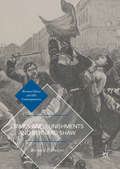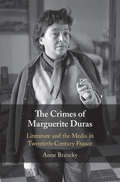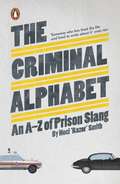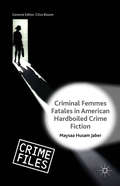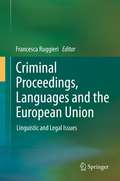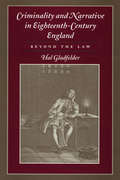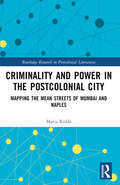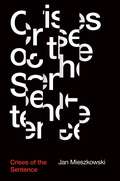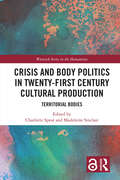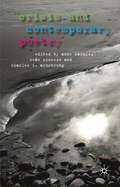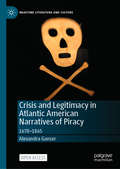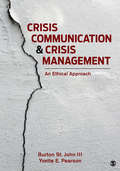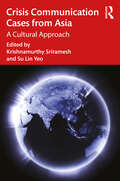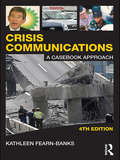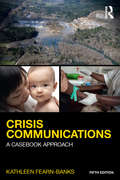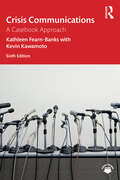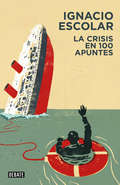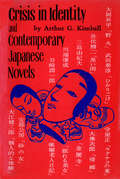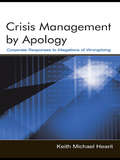- Table View
- List View
Crimes and Punishments and Bernard Shaw (Bernard Shaw and His Contemporaries)
by Bernard F. DukoreThis book analyzes the interaction of crimes, punishments, and Bernard Shaw in the nineteenth and twentieth centuries. It explores crimes committed by professional criminals, nonprofessional criminals, businessmen, believers in a cause, the police, the Government, and prison officials. It examines punishments decreed by judges, juries, colonial governors, commissars, and administered by the police, prison warders, and prison doctors. It charts Shaw's view of crimes and punishments in dramatic writings, non-dramatic writings, and his actions in real life. This book presents him in the context of his contemporaries and his world, inviting readers to view crimes and punishments in their context, history, and relevance to his ideas in and outside his plays, plus the relevance of his ideas to crimes and punishments in life.
The Crimes of Marguerite Duras: Literature and the Media in Twentieth-Century France
by Anne BranckyOne of the most celebrated authors of twentieth-century France, Marguerite Duras loved crime. Indeed, criminal faits divers from the newspaper represented a key element in her literary project. Sensational news stories made their way into her novels, plays and screenplays, inspired numerous journalistic pieces and media interventions, and even informed the way that she discussed her life and work in the press. The Crimes of Marguerite Duras offers an innovative framework for analyzing Duras's literary works and journalism as they relate to the mass media and broader cultural debates. Anne Brancky reveals how Duras's predilection for provocatively blurring the line between truth and fiction on various media platforms helped make her a best-selling author and a public intellectual ahead of her time. Exploring the movement between serious literature and public scandal, this readable book affirms literature's abiding role in political debate and the public sphere.
The Criminal Alphabet: An A-Z of Prison Slang
by Noel 'Razor' Smith'I have spent almost 33 of the last 53 years in and out of prison, but mainly in. I was a juvenile offender back in the mid 1970s and went on to become an adult prisoner in the 1980s and beyond. My shortest prison sentence was 7 days (for criminal damage) and my longest sentence was life (for bank robbery and possession of firearms). I have 58 criminal convictions for everything from attempted theft to armed robbery and prison escape, and I was a career criminal for most of my life. What I do not know about criminal and prison slang could be written on the back of a postage stamp and still leave room for The Lord's Prayer ...'From ex-professional bank robber and bestselling author Noel Smith, this is the most authoritative dictionary of criminal slang out there - and an unmissable journey, through words, into the heart of the criminal world.
Criminal Cities: The Postcolonial Novel and Cathartic Crime (Cultural Frames, Framing Culture)
by Molly SlavinWhy does crime feature at the center of so many postcolonial novels set in major cities? This book interrogates the connections that can be found between narratives of crime, cities, and colonialism to bring to light the ramifications of this literary preoccupation, as well as possibilities for cultural, aesthetic, and political catharsis.Examining late-twentieth- and twenty-first-century novels set in London, Belfast, Mumbai, Sydney, Johannesburg, Nairobi, and urban areas in the Palestinian West Bank, Criminal Cities considers the marks left by neocolonialism and imperialism on the structures, institutions, and cartographies of twenty-first-century cities. Molly Slavin suggests that literary depictions of urban crime can offer unique capabilities for literary characters, as well as readers, to process and negotiate that lingering colonial violence, while also providing avenues for justice and forms of reparations.
The Criminal Crowd and Other Writings on Mass Society (Lorenzo Da Ponte Italian Library)
by Nicoletta Pireddu Tom Huhn Scipio SigheleThe Criminal Crowd and Other Writings on Mass Society is the first English collection of writings by Italian jurist, sociologist, cultural and literary critic Scipio Sighele. Sighele is largely responsible for providing post-unification Italy with a new outlook on issues ranging from the blurring line between individual and collective accountability, the role of urbanization in the development of criminality, and the emancipation of women. This work draws a multifaceted portrait of a provocative thinker and public intellectual caught between tradition and modernity during the European fin de siècle. Containing a comprehensive introduction by the editor, The Criminal Crowd and Other Writings on Mass Society includes Sighele’s seminal work, The Criminal Crowd, as well as his formative studies on group behaviour. Nicoletta Pireddu contextualizes Sighele’s contribution to the so-called ‘age-of crowds,’ from the fierce polemic with his French rivals Gustave LeBon and Gabriel Tarde to the scientific, literary, and cultural developments of his conceptualization of mass behaviours as a legitimate object of psychological investigation into a new century.
Criminal Femmes Fatales in American Hardboiled Crime Fiction (Crime Files)
by Maysaa Husam JaberThis book fills a gap in both literary and feminist scholarship by offering the first major study of femme fatales in hardboiled crime fiction. Maysaa Jaber shows that the criminal literary figures in the genre open up powerful spaces for imagining female agency in direct opposition to the constraining forces of patriarchy and misogyny.
Criminal Law and the Modernist Novel
by Rex FergusonThe realist novel and the modern criminal trial both came to fruition in the nineteenth century. Each places a premium on the author's or trial lawyer's ability to reconstruct reality, reflecting modernity's preoccupation with firsthand experience as the basis of epistemological authority. But by the early twentieth century experience had, as Walter Benjamin put it, "fallen in value. " The modernist novel and the criminal trial of the period began taking cues from a kind of nonexperience - one that nullifies identity, subverts repetition, and supplants presence with absence. Rex Ferguson examines how such nonexperience colours the overlapping relationship between law and literary modernism. Chapters on E. M. Forster's A Passage to India, Ford Madox Ford's The Good Soldier, and Marcel Proust's In Search of Lost Time detail the development of a uniquely modern subjectivity, offering new critical insight to scholars and students of twentieth-century literature, cultural studies, and the history of law and philosophy.
Criminal Proceedings, Languages and the European Union: Linguistic and Legal Issues
by Francesca RuggieriThe book "Criminal proceedings, languages and the European Union: linguistic and legal issues" - the first attempt on this subject - deals with the current situation in the jurislinguistic studies, which cover comparative law, language and translation, towards the aim of the circulation of equivalent legal concepts in systems which are still very different from one another. In the absence of common cultures and languages, in criminal procedure it is possible to distinguish features that are typical of common law systems and features that are typical of civil law systems, according to the two different models of adversarial and inquisitorial trials. Therefore, the most problematic challenges are for the European Union legislator to define generic measures that can be easily implemented at the national level, and for the individual Member States to choose corresponding domestic measures that can best implement these broad definitions, so as to pursue objectives set at the European level.In this scenario, the book assesses the new framework within which criminal lawyers and practitioners need to operate under the Lisbon Treaty (Part I), and focuses on the different versions of its provisions concerning cooperation in criminal matters, which will need to be implemented at the national level (Part III). The book analyses the issues raised by multilingualism in the EU decision-making process and subsequent interpretation of legal acts from the viewpoint of all the players involved (EU officials, civil, penal and linguistic lawyers: Part II), explores the possible impact of the EU legal acts concerning environmental protection, where the study of ascending and descending circulation of polysemantic words is especially relevant (Part IV), and investigates the new legal and linguistic concepts in the field of data retention, protection of victims, European investigation orders and coercive measures (Part V).
Criminality and Narrative in Eighteenth-Century England: Beyond the Law
by Hal GladfelderStories of transgression–Gilgamesh, Prometheus, Oedipus, Eve—may be integral to every culture's narrative imaginings of its own origins, but such stories assumed different meanings with the burgeoning interest in modern histories of crime and punishment in the later decades of the seventeenth century. In Criminality and Narrative in Eighteenth-Century England, Hal Gladfelder shows how the trial report, providence book, criminal biography, and gallows speech came into new commercial prominence and brought into focus what was most disturbing, and most exciting, about contemporary experience. These narratives of violence, theft, disruptive sexuality, and rebellion compelled their readers to sort through fragmentary or contested evidence, anticipating the openness to discordant meanings and discrepant points of view which characterizes the later fictions of Defoe and Fielding.Beginning with the various genres of crime narrative, Gladfelder maps a complex network of discourses that collectively embodied the range of responses to the transgressive at the turn of the eighteenth century. In the book's second and third parts, he demonstrates how the discourses of criminality became enmeshed with emerging novelistic conceptions of character and narrative form. With special attention to Colonel Jack, Moll Flanders, and Roxana, Gladfelder argues that Defoe's narratives concentrate on the forces that shape identity, especially under conditions of outlawry, social dislocation, and urban poverty. He next considers Fielding's double career as author and magistrate, analyzing the interaction between his fiction and such texts as the aggressively polemical Enquiry into the Causes of the Late Increase in Robbers and his eyewitness accounts of the sensational Canning and Penlez cases. Finally, Gladfelder turns to Godwin's Caleb Williams, Wollstonecraft's Maria, and Inchbald's Nature and Art to reveal the degree to which criminal narrative, by the end of the eighteenth century, had become a necessary vehicle for articulating fundamental cultural anxieties and longings. Crime narratives, he argues, vividly embody the struggles of individuals to define their place in the suddenly unfamiliar world of modernity.
Criminality and Power in the Postcolonial City: Mapping the Mean Streets of Mumbai and Naples
by Maria RiddaThis book investigates the literary imaginings of the postcolonial city through the lens of crime in texts set in Naples and Mumbai from the 1990s to the present. Employing the analogy of a ‘black hole,’ it posits the discourse on criminality as a way to investigate the contemporary spatial manifestations of coloniality and global capitalist urbanity. Despite their different histories, Mumbai and Naples have remarkable similarities. Both are port cities, ‘gateways’ to their countries and regional trade networks, and both are marked by extreme wealth and poverty. They are also the sites and symbolic battlegrounds for a wider struggle in which ‘the North exploits the South, and the South fights back.’ As one of the characters of the novel The Neapolitan Book of the Dead puts it, a narrativisation of the underworld allows for a ‘discovery of a different city from its forgotten corners.’ Crime provides a means to understand the relationship between space and society/culture in a number of cities across the Global South, by tracing a narrative of postcolonial urbanity that exposes the connections between exploitation and the ongoing ‘coloniality of power.’
Crises of the Sentence
by Jan MieszkowskiThere are few forms in which so much authority has been invested with so little reflection as the sentence. Though a fundamental unit of discourse, it has rarely been an explicit object of inquiry, often taking a back seat to concepts such as the word, trope, line, or stanza. To understand what is at stake in thinking—or not thinking—about the sentence, Jan Mieszkowski looks at the difficulties confronting nineteenth- and twentieth-century authors when they try to explain what a sentence is and what it can do. From Romantic debates about the power of the stand-alone sentence, to the realist obsession with precision and revision, to modernist experiments with ungovernable forms, Mieszkowski explores the hidden allegiances behind our ever-changing stylistic ideals. By showing how an investment in superior writing has always been an ethical and a political as well as an aesthetic commitment, Crises of the Sentence offers a new perspective on our love-hate relationship with this fundamental compositional category.
Crisis and Body Politics in Twenty-First Century Cultural Production: Territorial Bodies (Warwick Series in the Humanities)
by Charlotte Spear Madeleine SinclairThe twenty-first century has been deemed the “Age of Crisis”. We are witnessing the catastrophic unfolding of environmental crisis, financial crisis, pandemic and conflict. But are we to understand these crises as new phenomena? Is their seemingly simultaneous existence purely coincidental? Or rather do they instead form part of a singular, historically produced, unfolding crisis, which only today has reached a generalised consciousness? And perhaps most urgently, how far can we separate the crises of human experience from those exacted upon the land?The chapters collected in Crisis and Body Politics in Twenty-First Century Cultural Production: Territorial Bodies deploy the framework of “Territorial Bodies” to address urgent social, ecological and political challenges. Examining themes such as (inter)national bodily governance, racialised bodies, eco-feminist movements, spatial justice and bodily displacement, this collection provides a deeper analysis of the interconnected forms of violence perpetrated against marginalised human and non-human bodies, taking this combined violence as the defining feature of contemporary crisis.
Crisis and Contemporary Poetry
by Anne Karhio Seán Crosson Charles I. ArmstrongWhat are the means available to poetry to address crisis and how can both poets and critics meet the conflicts and challenges they face? This collection of essays addresses poetic and critical responses to the various crises encountered by contemporary writers and our society, from the Holocaust to the ecological crisis.
Crisis and Legitimacy in Atlantic American Narratives of Piracy: 1678-1865 (Maritime Literature and Culture)
by Alexandra GanserThis Open Access book, Crisis and Legitimacy in Atlantic American Narratives of Piracy: 1678-1865, examines literary and visual representations of piracy beginning with A.O. Exquemelin’s 1678 Buccaneers of America and ending at the onset of the US-American Civil War. Examining both canonical and understudied texts—from Puritan sermons, James Fenimore Cooper’s The Red Rover, and Herman Melville’s “Benito Cereno” to the popular cross-dressing female pirate novelette Fanny Campbell, and satirical decorated Union envelopes, this book argues that piracy acted as a trope to negotiate ideas of legitimacy in the contexts of U.S. colonialism, nationalism, and expansionism. The readings demonstrate how pirates were invoked in transatlantic literary production at times when dominant conceptions of legitimacy, built upon categorizations of race, class, and gender, had come into crisis. As popular and mobile maritime outlaw figures, it is suggested, pirates asked questions about might and right at critical moments of Atlantic history.
Crisis Communication: Theory and Practice
by Alan Jay ZarembaCrises happen. When they do, organizations must learn to effectively communicate with their internal and external stakeholders, as well as the public, in order to salvage their reputation and achieve long-term positive effects. Ineffective communication during times of crisis can indelibly stain an organization’s reputation in the eyes of both the public and the members of the organization. The subject of crisis communication has evolved from a public relations paradigm of reactive image control to an examination of both internal and external communication, which requires proactive as well as reactive planning. There are many challenges in this text, for crisis communication involves more than case analysis; students must examine theories and then apply these principles. This text prepares students by: Providing a theoretical framework for understanding crisis communication Examining the recommendations of academics and practitioners Reviewing cases that required efficient communication during crises Describing the steps and stages for crisis communication planning Crisis Communication is a highly readable blend of theory and practice that provides students with a solid foundation for effective crisis communication.
Crisis Communication and Crisis Management: An Ethical Approach
by Yvette E. Pearson Burton St. JohnCrisis Communication and Crisis Management: An Ethical Approach is the only text on the market to provide students with the integration of ethical inquiry into the fundamentals of crisis communication.. Authors Burton St. John III and Yvette E. Pearson combine comprehensive coverage of the key skills, concepts, and theories of crisis communication with an extensive collection of contemporary case studies, giving students a strong understanding of the essential role that communicators play in moments of crisis. Students are encouraged to build upon their communication and ethical decision making skills using a variety of stakeholder inventories, hypothetical scenarios, discussion questions, and professional profiles. Students will also gain exposure to a mixture of discrete and ongoing crises, preparing them to manage both one-time crises and continuing crises.
Crisis Communication and Crisis Management: An Ethical Approach
by Yvette E. Pearson Burton St. JohnCrisis Communication and Crisis Management: An Ethical Approach is the only text on the market to provide students with the integration of ethical inquiry into the fundamentals of crisis communication.. Authors Burton St. John III and Yvette E. Pearson combine comprehensive coverage of the key skills, concepts, and theories of crisis communication with an extensive collection of contemporary case studies, giving students a strong understanding of the essential role that communicators play in moments of crisis. Students are encouraged to build upon their communication and ethical decision making skills using a variety of stakeholder inventories, hypothetical scenarios, discussion questions, and professional profiles. Students will also gain exposure to a mixture of discrete and ongoing crises, preparing them to manage both one-time crises and continuing crises.
Crisis Communication Cases from Asia: A Cultural Approach
by Krishnamurthy Sriramesh Su Lin YeoThis book analyzes crisis communication in Asia, focusing on how culture (broadly defined) plays a central role in the way a crisis develops and is resolved.Using the case study method, this book offers the reader glimpses of the variety of cultures in the continent, displaying the complexity of the cross-cultural process of conducting crisis communication in this diverse environment. Each of these cases addresses the onset, evolution, and resolution of the crisis. The contributors are seasoned practitioners who have done crisis communication work in this continent and have used the same framework of five environmental variables that define culture in this book: political culture, economic systems, societal culture, media systems, and activist environments.This edited volume is ideal for scholars and advanced students in public relations and strategic communication generally and crisis communication specifically.
Crisis Communications
by Kathleen Fearn-BanksCrisis Communications: A Casebook Approach presents case studies of organizational, corporate, and individual crises, and analyzes the communication responses to these situations. Demonstrating how professionals prepare for and respond to crises, as well as how they develop communications plans, this essential text explores crucial issues concerning communication with the news media, employees, and consumers in times of crisis. Author Kathleen Fearn-Banks examines the steps of choosing the appropriate words to convey a message, selecting the method and channels for delivering the message, and identifying and targeting the most appropriate publics or audiences. She also addresses such important topics as avoiding potential mismanagement of communication in crisis situations. Key features of this fourth edition are: six new cases, including several international crises current discussion of communications technology as it relates to crises a Companion Website -- www.routledge.com/textbooks/fearn-banks -- with additional cases as well as supplemental materials for students and classroom resources for instructors. A Student Workbook is also available for use with this volume, providing additional pedagogy for each chapter, including discussion questions, activities, key terms, case exercises, and worksheets. Utilizing both classic and contemporary cases of real-world situations, Crisis Communications provides students in public relations and business with real-world perspectives and valuable insights for professional responses to crises. It is intended for use in crisis communications, crisis management, and PR case studies courses.
Crisis Communications: A Casebook Approach (Routledge Communication Series)
by Kathleen Fearn-BanksCrisis Communications: A Casebook Approach presents case studies of organizational, corporate, and individual crises, and analyzes the communication responses to these situations. Demonstrating how professionals prepare for and respond to crises, as well as how they develop communications plans, this essential text explores crucial issues concerning communication with the news media, employees, and consumers in times of crisis. Author Kathleen Fearn-Banks addresses how to choose the best possible words to convey a message, the best method for delivering the message, and the precise and most appropriate audience, in addition to illustrating how to avoid potential mismanagement. The fifth edition of Crisis Communications includes updated cases that provide wider coverage of international crises and media technologies. It includes a new section on social media in crisis communication scenarios and includes additional comments from social media experts throughout various chapters. New case studies include "Police Departments and Community Trust," "The Oso Mudslide in Washington," "School Shootings: Communications To and For Children," and two additional international case studies - "Ebola Strikes Liberia: Firestone Strikes Ebola" and "Nut Rage and Korean Airlines." Previous case studies no longer in this edition can be found on the book’s companion website, which also includes the Instructor’s Manual with exercises in crisis responses, guidelines for crisis manual preparation, and other teaching tools: www.routledge.com/cw/fearn-banks. Looking at both classic and modern cases in real-world situations, Crisis Communications provides students with real-world perspectives and insights for professional responses to crises. It is intended for use in crisis communications, crisis management, and PR case studies courses. Also available for use with this text is the Student Workbook to Accompany Crisis Communications, providing additional discussion questions, activities, key terms, case exercises, and further content for each chapter.
Crisis Communications: A Casebook Approach (ISSN)
by Kathleen Fearn-Banks Kevin KawamotoNow in its sixth edition, this book provides engaging, practice-oriented case studies analyzing communication professionals’ crisis preparation and responses, illustrating key considerations for communicating with both internal and external stakeholders during and after a crisis.This edition continues its strength as a student-friendly text that demonstrates how to craft, target, and deliver messages during crises in order to mitigate further controversy and distress. Classic cases lay the foundation, while contemporary cases shed light on cutting-edge practices in use today. Many cases from previous editions have been updated and new cases added, including the COVID-19 crisis and U.S. vaccination campaign; Starbucks and racial discrimination at a Philadelphia branch; Will Smith and the Academiy Awards slap; Gander, Newfoundland in supporting stranded tourists after the attacks of September 11, 2001; and a look at how schools can prepare communication responses to school shootings. Each case pays particular attention to the actual and ideal use of social media in the crisis and there is a new section on the important issues of misinformation and disinformation.Crisis Communications, 6th Edition is intended for courses in crisis communication, crisis management, disaster response, corporate communications, and public relations.Student and instructor online support materials feature selected previous editions’ case studies no longer in this edition as well as an Instructor’s Manual with suggested activities, discussion questions, and sample quizzes: www.routledge.com/9780367894450.
La crisis en 100 apuntes (Libros para entender la crisis #Volumen)
by Ignacio EscolarLa historia de la crisis económica a través de los artículos de Ignacio Escolar Este libro es un pequeño diario de una enorme catástrofe: desde el asombro con el que descubrimos el agujero estadounidense de las subprime hasta el tsunami que nos barrió después y que ha desembocado en el incendio del euro, una crisis que aún no hemos logrado apagar, y donde los derechos de los trabajadores y el Estado del bienestar son lo primero en arder. Recordar el camino que hemos recorrido estos últimos cuatro años es tan doloroso como necesario: para valorar adónde vamos hay que saber de dónde venimos, y cómo hemos llegado hasta aquí. Porque la lucha del hombre contra el poder es la lucha de la memoria contra el olvido.
Crisis in Identity
by Arthur G. KimballThis book is intended to encourage the reading, study, and appreciation of contemporary Japanese fiction and, through it, an understanding of Japan and Japanese culture. The various chapters, including the Syllabus at the end, aim to stimulate and encourage general readers and students to deepen their knowledge of the available literature. The Syllabus in particular aims to encourage the teaching of Japanese literature in the classroom, at both high school and university level, by supplying the teacher and student with study aids. The book is based on an important and much-discussed contemporary theme, that of identity.
Crisis Management By Apology: Corporate Response to Allegations of Wrongdoing (Routledge Communication Series)
by Keith Michael HearitThis volume examines the role of apologia and apology in response to public attack. Author Keith Michael Hearit provides an introduction to these common components of public life, and considers a diverse list of subjects, from public figures and individuals to corporations and institutions. He explores the motivations and rationales behind apologies, and considers the ethics and legal liabilities of these actions. Hearit provides case studies throughout the volume, with many familiar examples from recent events in the United States, as well as an international apology-making case from Japan.The broad-perspective approach of this volume makes the content relevant and appealing to practitioners and scholars in public relations, business communications, and management. It is a valuable text for courses that take a discursive approach to public relations, and it also appeals to readers in business management, examining apology as a response strategy to corporate crises.
The Crisis Manager: Facing Disasters, Conflicts, and Failures (Lea’s Communication Series)
by Otto LerbingerResponding to the era of crises in which we now live, The Crisis Manager offers wise counsel for anticipating and responding to crises as well as taking the steps required to reduce the impact of these events. Spotlighting the reality of crisis at levels ranging from local to global, author Otto Lerbinger helps readers understand the approaches and ways of thinking required for successful crisis management in today's world. As no organization or individual is immune from crisis, he guides managers to make good decisions under conditions of high uncertainty, and to consider the interests not only of stockholders but also of a wide variety of stakeholders. With a focus on the threat of crises to an organization's most valuable asset - its reputation - The Crisis Manager covers: Preparation for crisis, including crisis communication planning Physical crises - natural, biological, and technological "Human climate" crises, stemming from targeted attacks on an organization's policies, actions, or physical holdings Crises due to management failure, including mismanagement, skewed values, deception, and misconduct New to this second edition are the use of social media in crisis management, and chapters on image restoration strategies and crises stemming from mismanagement, as well as a comprehensive updating of the entire work. Real-world case studies provide examples of what worked and what did not work, and the reasons why. Written for present and future crisis managers in all types of businesses and organizations, this resource will be required reading for students in public relations, business, and management, as it prepares them for their crucial roles as decision makers.
